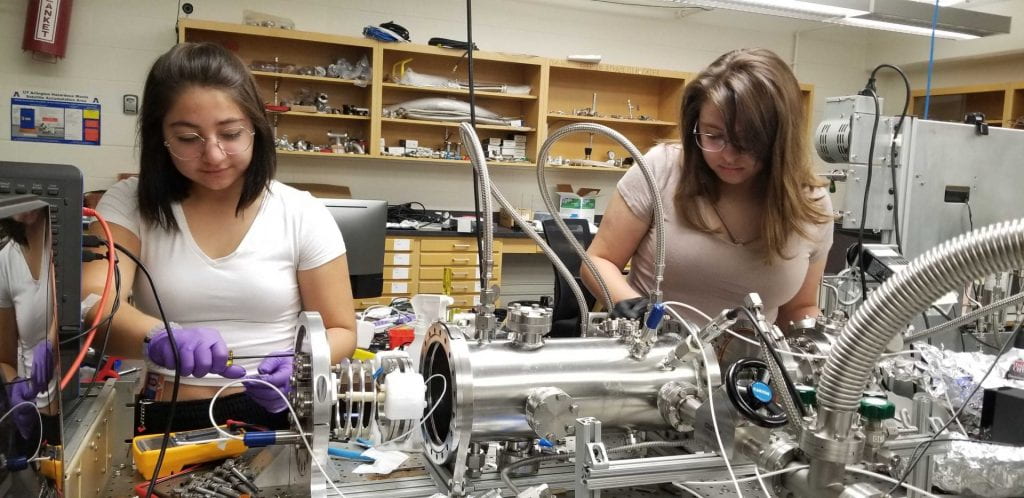
More than twenty undergraduate researchers have worked with us over the last three years, on projects ranging from software development, to particle detector construction, to physics data analysis. This page gives some information on what is involved in undergraduate research with our group, and presents a few profiles of our team members.
Who Can Join Us?
The most important requirements for working with us are a passion for science, and a desire to work, to learn, and to grow as a researcher.
For most projects we recruit physics majors; sometimes when a project needs specific expertise such as technical drawing, circuit design or involved computer programming, we will recruit engineering or computer science majors. In those cases, a Physics second major or minor is considered very positively. The people who will get the most out of working with us are those who would like to pursue a scientific career and / or PhD. Working in an active research group is an invaluable component of developing your resume for applying to graduate school, and many of our undergraduate assistants leave with publications, connections within the field, and strong reference letters.
We typically recruit new undergraduate assistants as sophomores or juniors, though freshmen who are especially enthusiastic are also encouraged to make contact.
What do we expect?
We have a few ground rules for our undergraduate assistants:
1) You must be making mostly A’s in your physics classes and keeping your GPA high. If you stop making mostly A’s or your GPA slips, we will encourage you to step away from research to focus on classes.
2) You should not work simultaneously with more than one research group. It is much better to do one research project well than two badly.
3) You must be able to spend ~5 hours per week on research most weeks (though not during finals and midterms.)
4) You should ideally always attend our weekly group meeting and present your progress, and if schedule allows, our journal club.
5) In most cases we try to work with people who will be available on campus for a good fraction of the summer break, since this is an opportunity to make focused progress. Though, this is negotiable (especially if you have other physics-based plans, for example, REU programs at other Universities).
Undergraduate Profile: Ibrahim Safa (Physics major)

Ibrahim worked with us on understanding the properties of the deep South Pole ice, and how the light propagating through it impacts the detection of neutrinos at the IceCube South Pole Neutrino Observatory. He laid the groundwork for the SnowStorm method, a novel way to propagate systematic uncertainties from calibration samples to physics analyses. The final algorithm based on his work was recently published in the Journal of Cosmology and Astro-Particle Physics. While a UTA undergraduate he made several trips to collaborate with IceCube scientists around the United States, and attended and presented at the IceCube collaboration meeting at Madison, Wisconsin. He then completed his PhD at UW Madison, developing new searches for dark matter and better understanding the properties of astrophysical neutrinos crossing the Earth. Ibrahim is now a postdoctoral researcher at Columbia University, working on neutrino physics within the SBND collaboration.
Undergraduate Profile: Jackie Baeza Rubio (Physics major)

Jackie joined us as a high school intern, and made contributions to many projects during her time in the group. These include assisting with experiments on the electrical breakdown strength of noble gases; computational studies of electron drift in various gas mixtures; electric field computations to understand the behavior of electrons in the NEXT detector; and construction of a Paul trap for charged particle trapping. She is an author on a peer-reviewed publication in the Journal of Instrumentation and has presented her work at the Conference for Undergraduate Women in Physics (pictured). She was a crucial participant in the NEXT-CRAB0 time projection chamber project where she developed the slow controls system for the time projection chamber, and undertook calculations that enabled our barium dication beam. While in our group, Jackie served as the Undergraduate Representative for the National Society of Hispanic Physicists. She graduated in 2023, and is now a pursuing her PhD in Physics at Yale University.
Undergraduate Profile: Sanmitra Pingulkar (Engineering major)

Sanmitra joined us as an engineering assistant as a sophomore. He made major contributions to the NEXT-100 experiment, including making technical drawings for the electroluminescent region and cathode, and making conceptual designs for NEXT-ton including its scalable field cage. He has designed parts of many systems in our lab including tests of RF carpets for barium ion transport. He built and tested the gas system for the Mothership test vessel and works as one of the main operators of this facility (pictured). He presented his work at the Texas Section of the American Physical Society, and is an author on a publication on cosmogenic background mitigation for the NEXT experiment. Sanmitra moved to New York City to work as a professional engineer at the Square Roots microgreens startup n Brooklyn. He came back to engineering for Fundamental Physics in 2023, and is now working as mechanical engineer contributing to construction of the DUNE neutrino detector at the Sanford Laboratory in Lead, South Dakota.